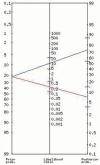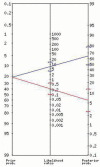The Value of the "Lab-Score" Method in Identifying Febrile Infants at Risk for Serious Bacterial Infections
- PMID: 29967810
- PMCID: PMC5953283
- DOI: 10.1515/jccm-2015-0003
The Value of the "Lab-Score" Method in Identifying Febrile Infants at Risk for Serious Bacterial Infections
Abstract
Introduction: Most children with fever without source will have a self limited viral infection though a small percent will develop a serious bacterial infection (SBI) like urinary tract infection, pneumonia, bacteraemia, meningitis or sepsis. The challenge facing practitioners is to distinguish between these two groups and currently biomarkers, like C-reactive protein (CRP) and Procalcitonin (PCT), are available for this purpose.The aim of the current study was to identify SBI in infants with fever without an identifiable cause using the recently introduced "Lab-score" combining C-reactive protein, procalcitonin and urine dipstick results.
Methods: This survey is part of an observational study aimed at identifying children with fever without source at risk of SBI. Patients were recruited from the Emergency Department of Tîrgu Mures Emergency Clinical County Hospital, Romania, during 2013. SBI diagnosis was based on urine, blood and cerebrospinal fluid cultures and chest radiographs. For infants, aged 7 days to 12 months, CRP and PCT were determined and the "Lab-score" was calculated. Positive and negative likelihood ratios and post test probabilities were calculated for each parameter and score.
Results: Of the ninety infants included in the study, SBI was diagnosed in nineteen (21.11%). Ten had a urinary tract infection, seven had pneumonia, one had a urinary tract infection and bacteraemia, and one had sepsis. Positive and negative likelihood ratios for CRP (≥40.0 mg/L) and PCT (≥0.5 ng/mL) were 10.27/0.45 and 7.07/0.24 and post-test probabilities 73%/65%. For a "Lab-score" (≥3), positive and negative likelihood ratios were 10.43/0.28, and the posttest probability was 73%.
Conclusions: In our survey the "Lab-score" proved a strong predictor for the identification of febrile infants at risk of SBI, but showed no significant difference compared with CRP and PCT which both proved equally good predictors for SBI.
Keywords: fever; infants; serious bacterial infections; “Lab-score”.
Conflict of interest statement
Conflict of interest: None declared.
Figures



References
-
- Baraff LJ.. Management of infants and young children with fever without source. Pediatr Ann. 2008;37:673–9. - PubMed
-
- Galetto Lacour A, Zamora SA, Gervaix A.. Bedside procalcitonin and C-reactive protein tests in children with fever without localizing signs of infection seen in a referralcenter. Paediatrics. 2003;112:1054–60. - PubMed
-
- Van den Bruel A, Haj-Hassan T, Thompson M, Buntinx F, Mant D.. Diagnostic value of clinical features at presentation to identify serious infection in children in developed countries: a systematic review. Lancet. 2010;375:834–45. - PubMed
-
- Van den Bruel A, Thompson MJ, Haj-Hassan T. et al. Diagnostic value of laboratory tests in identifying serious infections in febrile children: systematic review. BMJ. 2011;342:d3082. - PubMed
LinkOut - more resources
Full Text Sources
Other Literature Sources
Research Materials
Miscellaneous
